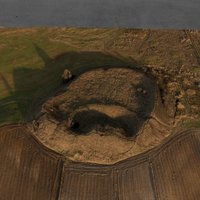Hillfort - Zabytek.pl
Address
Błonie
Location
woj. mazowieckie, pow. warszawski zachodni, gm. Błonie - miasto
Location and description
The hill fort known as “Łysa Góra” (“Bald Mountain”) is located at the northeastern edge of the Błonie commune - city, approx. 400 m to the north of the road from Warsaw to Błonie. It was erected on the borderland between waterlogged meadows by the Utrata river, on a natural hill. The regulated river bed is located about 100 m to the north-east of the hill fort, whereas the older channel was running approx. 40 m away from the new one.
The hill fort in Błonie consists of two sections. In its southern part there is a conical hill up to 8 metres high, surrounded by a semicircular moat and rampart on its northern side. The northern part, which is larger and lower than the southern section and also surrounded with a moat and rampart, adjoins the rampart. One more line of rampart and moat was intended as a defence to protect the settlement from the south. As early as in the 70s they were significantly levelled due to ploughing. Also in the 70s the traces of pits, trenches and ploughing of ramparts were visible on the surface of the site. The area of the hill fort located on the edge of arable fields is currently overgrown with grass.
History
The fortified settlement in Błonie was a seat of dukes Siemowit I and Konrad II. Around 1253, Duke Siemowit funded a Holy Trinity church in the area of Błonie. The church was elevated to a collegiate church modelled on churches located in major centres of ducal demesne. In 1257, two altars were consecrated, and the town is mentioned as “Blone” in written records. In 1288, as T. Kiersnowska wrote: “During the period of decline in the number of people living in the ducal manor adjacent to the collegiate church” Konrad II of Mazovia gave the church and lands to the monastery of Canons Regular in the village of Czerwińsk.
Condition and results of archaeological research
The verification and surface surveys of the hill fort were carried out in 1923, and for the second time in 1949. Research excavations were undertaken by the State Archaeological Museum (Państwowe Muzeum Archeologiczne) (A. Cofta) between 1949 and 1951. Complementary research in 1971 were conducted by T. Kiersnowska from the Institute of History of Material Culture of the Polish Academy of Sciences. In 1984, the hill fort was registered during the surface surveys carried out within the framework of the “Archaeological Picture of Poland” project.
The research covered two parts of the hill fort. It was agreed that the rampart surrounding the northern part of the fortified settlement was built in a sandwich construction (layers of logs stacked alternately along and perpendicular to the axis of fortification). From the outside it was covered with a layer of clay, which has been burnt. From the inside it was strengthened with an additional coating of stone. The rampart separating the guard part of the fortified settlement was made of sand and clay excavated in the process of digging the moat. Within the area of the conical hill, traces of a wooden structure have been found in the southern part. According to researchers, in combination with a small amount of historical material this demonstrates that it served as a watchtower and shelter for the inhabitants of the hill fort. In the northern residential part of the site a number of utility buildings were discovered, such as a goldsmith workshop, smokehouse, small cellar, rooms for softening horn. The remains of a large residential building interpreted by T. Kiersnowska as a ducal manor were found on the eastern side, near to the rampart. Numerous fragments of hand-made bricks, ceramic building decorations, pottery and dozens of metal items were found in the fill of the feature. Traces of a horn workshop and food storehouse were also found on this site (the finds included the remains of fish, including, but not limited to, two-metre-long Acipenser oxyrinchus and shoulder blades of ten bovine animals).
Movable finds included iron and horn buckles, bracelet and ring of bronze, glass bead, keys and padlocks for boxes, keys to the gates and staple, scissors, needles, pins, spindle whorls, awls, 2 whetstones. A glazed ceramic miniature man’s head was an exceptional find. A similar head was found in Bergen in Norway — it was a thirteenth-century toy, probable a baby’s rattle brought from the south-east of England.
The development of the fortified settlment site, including a brick manor house, workshops, fortifications with a watchtower, and unique imports prove the fact that we are dealing with the former seat of a magnate family most likely associated with the ruling family. According to T. Kiersnowska, apart from Jazdów and Trojanów, the hill fort in Błonie was one of three ducal seats which served as the centres of rural settlement units separated in the area of the ducal estate.
The hill fort is located in the area of land being private property and is not open to visitors. The building is, however, well visible from the Warsaw to Błonie road.
Compiled by Agnieszka Oniszczuk, National Heritage Board of Poland, 23.06.2015 r.
Bibliography
- Kiersnowska T., Trzynastowieczna siedziba książęca w Błoniu, „Kwartalnik Historii Kultury Materialnej“ 1971, Y. XIX, no. 3, pp. 447-462.
- Kiersnowska T., Błonie, pow. Pruszków, „Informator Archeologiczny”, Badania rok 1971, 1972, pp. 159-160.
- Paderewska L., Błonie, gmina loco (d. pow. Pruszków), woj. stołeczne warszawskie, [in:] Grodziska Mazowsza i Podlasia (w granicach dawnego województwa warszawskiego), collective work, Wrocław -Warszawa -Kraków -Gdańsk, 1976, pp. 21-24.
- Suchodolski S., Grójec wczesnośredniowieczny w świetle badań wykopaliskowych przeprowadzonych w roku 1976, „Sprawozdania Archeologiczne, vol. XXXI, 1979, p. 222.
Category: hillfort
Protection: Register of monuments, Monuments records
Inspire id: PL.1.9.ZIPOZ.NID_A_14_AR.42841, PL.1.9.ZIPOZ.NID_E_14_AR.1998273
